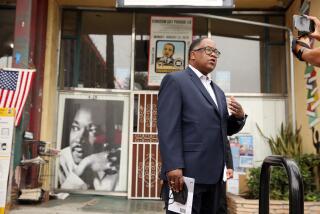Jerry Brown’s office accused of playing politics over freed inmate
- Share via
An attorney for a man wrongly convicted of murder accused California Atty. Gen. Jerry Brown’s office Thursday of waiting until after the November election to seek to return the man to prison on a technicality.
But Jim Humes, Brown’s chief deputy, said politics played no role in the proposed delay, saying the attorney general needed extra time to examine the case.
“We would like some more time to think about this,” Humes said in a telephone interview Thursday. “I know [the attorney general] cares about this case and wants to consider it fully” before making a decision about whether to proceed with the motion.
But attorney William Genego, who represents freed inmate Bruce Lisker, said he believes the request is designed to push the controversial matter until after the election.
“They are playing politics with an innocent man’s freedom,” Genego said.
Lisker, 45, was convicted of killing his mother in 1985. He was released from prison last year after a judge found that he was convicted on “false evidence” and had been inadequately represented by his trial attorney. The judge’s findings mirrored those of a 2005 Times investigation that raised questions about key elements of the prosecution’s case against Lisker and exposed the Los Angeles Police Department’s murder investigation as sloppy and incomplete.
Earlier this month, the attorney general filed a motion asking a judge to reverse her decision to overturn Lisker’s conviction because he had missed a deadline years ago by which to file his appeal.
The attorney general’s motion hinges on a U.S. 9th Circuit Court of Appeals ruling in a different case decided in July. In that case, a man’s conviction for child sex abuse and sodomy had been overturned by a district court judge even though he had missed a federal deadline in which to file his habeas corpus petition. As in the Lisker case, the district court judge determined after evidentiary hearings that the man, Richard Lee, had met an “actual innocence” exception to the deadline.
The 9th Circuit reversed that ruling. The judges noted the overturning of Lisker’s conviction and said there was a “widening split among the district courts of our circuit on whether there is an actual innocence exception.” They concluded that no such exception exists and reinstated Lee’s conviction.
Because of the Lee decision, the attorney general contends in the motion that U.S. District Judge Virginia Phillips should vacate her ruling in Lisker’s case. The attorney general’s motion was criticized by some legal experts as inappropriate after The Times reported on the legal maneuver.
Hours after The Times posted an article about the motion on its website, a spokesman for the attorney general said the office was reviewing the matter and was considering withdrawing it.
On Wednesday, Deputy Atty. Gen. Robert D. Breton called one of Lisker’s attorneys, seeking to continue the matter until mid-November, Genego said. He said Breton refused to say why he wanted to continue the matter, which is scheduled to be litigated Oct. 4. Genego said he would agree to continue the matter until the end of October.
Humes said neither he nor Brown were informed of Breton’s plan to file the motion. He said someone called it to his attention afterward, and he thought the move should be reconsidered. He said he sought the extension with the hope of providing Brown with a complete assessment of the case that would enable him to personally decide whether to proceed with the motion.
“To me, a continuation of the hearing is in everyone’s best interests, including — and maybe especially — Mr. Lisker’s,” Humes said.
Lisker’s legal saga began March 10, 1983, when he said he found his mother badly beaten and stabbed in the family’s home in Sherman Oaks and called paramedics for help.
Detectives were immediately suspicious of Lisker, a frizzy-haired 17-year-old with a history of drug abuse and fighting with his mother. His relationship with his parents had deteriorated to the point that they were paying for him to live in a nearby studio apartment.
Lisker’s conviction was overturned when Phillips concluded that most of the evidence used to implicate him in the crime had been seriously undermined or proved false. For example, a bloody shoe print that prosecutors used to link Lisker to the killing has since been determined by the LAPD not to have been made by his shoes. Additionally, an LAPD crime analyst now says a bruise on the victim’s head was an apparent shoe impression that did not match the treads of Lisker’s shoes but was “similar in size and dimension” to the mysterious bloody shoe print found in the house.
More to Read
Sign up for Essential California
The most important California stories and recommendations in your inbox every morning.
You may occasionally receive promotional content from the Los Angeles Times.











